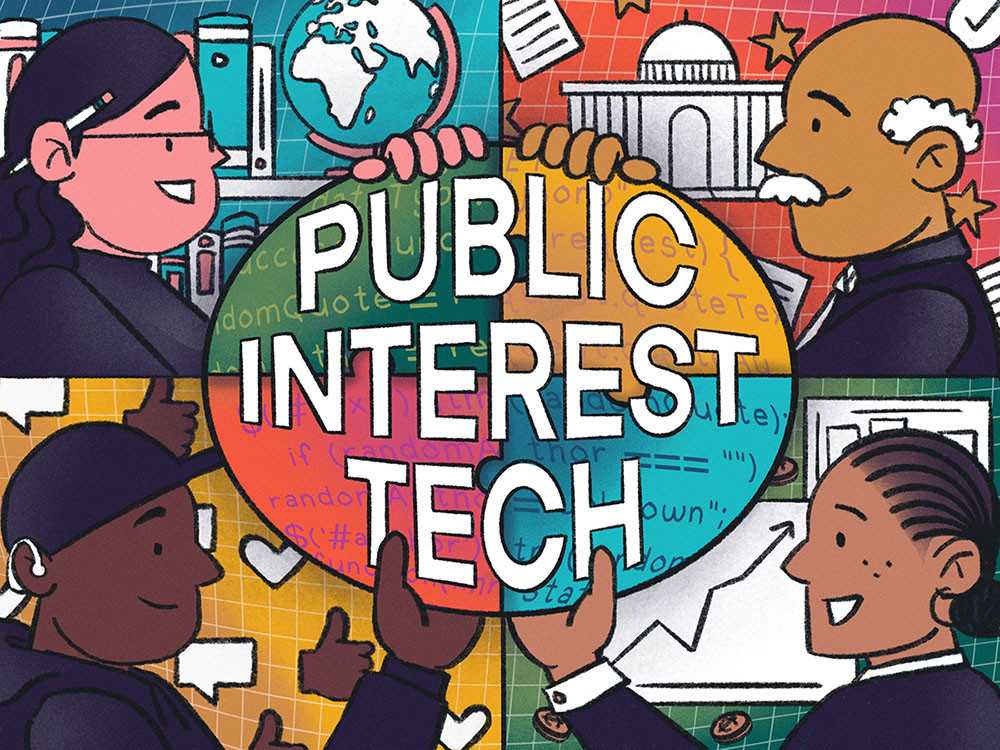 (Illustration by Vreni Stollberger)
(Illustration by Vreni Stollberger)
Michael Odiari, a Dallas-based entrepreneur, seeks to revolutionize traffic stops. He was motivated by his own experience, which includes a history of being pulled over by police and on one occasion, being forced to stare down the barrel of an officer’s gun.
After surviving this harrowing, yet all too common, experience for African Americans, Odiari harnessed his skills as a developer and created Check, a technology-based solution that allows drivers to use their mobile devices to send documents like a driver's license, registration, and proof of insurance to an officer, while both parties sit in their vehicle. This solution could increase safety at scale and calm the angst Odiari and others feel during traffic stops.

Check offers an example of the countless innovations that are possible when we invest in tech social entrepreneurs, or public interest technology (PIT) entrepreneurs, who represent a diversity of backgrounds and experiences. PIT entrepreneurs from historically marginalized communities have too often been passed over for funding, which stymies both equity and progress. Investing in PIT entrepreneurs who are marginalized based on race, identity, and class is an investment in innovative tech-based solutions to society’s most pressing personal and collective challenges, including the root causes of systemic inequality.
Marginalized individuals and practitioners bring the vital lens of their lived experiences to the field when it comes to leveraging technology for the common good and solving complex problems that disproportionately impact marginalized communities, like social justice, climate change, and access to quality health care, education, transportation, and affordable housing, just to a name few. Yet, the knowledge, voices, and expertise of those communities are often excluded from the design, development, and use of technology.
Often, the knowledge of a few subject-matter experts takes precedence and is elevated above all. If we continue to accept the status quo wherein the technologists who design and create our technological solutions remain largely white, male, cis-gender, wealthy individuals, then the technologies that shape our lives will continue to reinforce marginalization and perpetuate power imbalances. Recent negative treatment of public interest technologists like Timnit Gebru and Joy Buolamwini or the Socialgrlz S3 Trio, a team of young Black girls in high school who participated in a NASA innovation challenge and were targeted by racist harassment on the agency’s competition website after jumping ahead in votes, are just a few examples of the need for physical and digital spaces where historically marginalized people can share and develop knowledge together with allies in the tech ecosystem. These rooms and Zooms are critical to delivering the type of solutions that are fair and just.
Designing Digital Platforms That Elevate the Knowledge of Historically Marginalized Communities
There are a variety of systemic factors that have led to this status quo. In our report titled, “Building Career Pathways for Diverse Public Interest Technology Entrepreneurs,” we outline some of these factors like learning the unwritten rules, facing implicit biases, and encountering limited social capital and funding opportunities. But we believe the solution lies—at least in part—in creating a democratized, diverse, and inclusive community of researchers and practitioners in public interest technology that promotes knowledge development.
In our work, we are testing this assertion at the University of Michigan with the Public Interest Technology Knowledge Network (PIT-KN), a community-based learning platform co-designed with PIT entrepreneurs, students, and researchers. PIT-KN is a hub for public interest knowledge originating from marginalized communities and helps users create and develop knowledge-rich stories based on their lived experiences.
We approach this project with a simple premise that everyone possesses useful knowledge for design, regardless of their power and influence. It’s worth stating this obvious fact because as feminist theory has shown, the ways of knowing historically focus only on the experiences of white western men. PIT-KN aims to use technology to help move away from that mindset toward a broader, inclusive, and representative pool of knowledge. Aligned with feminist theory, PIT-KN places value on the embodied knowledge of the individual as a way of knowing and a starting point for further exploration.

Since the inception of PIT-KN, we have conducted research with early-stage PIT entrepreneurs and students. Our project has consisted of hosting an experiential learning course, one-on-one interviews and focus groups, surveys, student seminars, writing workshops, and system testing. PIT entrepreneurs in our project have provided an on-ramp to introduce students to the field. We share a similar appreciation for the innovative lens of this segment of underrepresented PIT practitioners that Calderini, Chiodo, et. al. outlined in their SSIR article, “Social-Tech Entrepreneurs: Building Blocks of a New Social Economy,” while also recognizing how their lens is further strengthened by their lived experiences shaped by race, gender, and class.
From our viewpoint, PIT entrepreneurs from marginalized communities have minimal visibility in the social sector. To address this diversity, equity, and inclusion problem, it’s vital to develop digital infrastructure that brings the knowledge of marginalized technologists into the public discourse. Below are three design principles that technologists and funders should consider when working to create a diverse, equitable, and inclusive future of technology.
1. Use storytelling to share knowledge and build collaboration with marginalized communities during co-design efforts.
Most PIT entrepreneurs share their knowledge through client emails, one-pagers, business plans, and funding proposals. They are likely not engaged in journalistic, academic, or creative writing activities that could leverage stories from their journey to inform innovative new products and services, as well as the future of public interest technology.
Marginalized technologists might believe the stories from their lived experiences are not worth sharing. For example, a PIT entrepreneur from our project who is addressing the lack of access to quality and affordable childcare services recalled how disheartened and exhausted she felt when “childcare experiences from parents seemed to be gaslighted” during a fundraising meeting. The funders she was talking with lacked context and failed to understand how families struggle to afford childcare largely because they “didn’t have any proximity to it.”
Creating spaces where users can share their practical knowledge of navigating social issues like access to affordable childcare can help validate individual experiences, develop connections outside of their networks, and create a trove of knowledge for technologists and funders developing tech-based solutions that benefit society. We’re inspired by the countless stories from PIT entrepreneurs like Tolu Olubunmi, a national advocate for immigration reform, who openly shares her story of growing up as undocumented and helps others share their stories, too. She reminds us that “change comes from the bottom up—from you, the individual, to the masses, and finally to the policy makers. These stories have the power to build connectivity for marginalized practitioners within the social sector and inform policy.”
2. Create pathways for students to learn by doing at the intersection of technology and society.
We get excited about opportunities that aim to appreciably raise the visibility of public interest technology for students by learning through doing. During our team’s experiential learning course, we matched students with PIT entrepreneurs who together used design thinking to move their product development efforts forward. After grappling with how to treat incomplete and biased data collected for a food as medicine app based in Detroit, one student in the course said, “If we know the concept of biases as indicated in Ruha Benjamin’s book, Race After Technology, we as product owners know the improvements we need to make in order to control for this problem.” The same student wondered, “Why would anyone use biased datasets to design products and services that are focused for a particular community?”
Through our project and other conversations with students we learned that while there has been an increase in course offerings and curriculum focused on public interest technology, there are no clear pathways into the field. Despite this difficulty, student interest in the field exists. For example, there are student groups across universities that are focussed on the intersection of technology and society, such as Tech 4 Social Good at the University of Michigan, Harvard Computer Society Tech for Social Good, and Stanford CS+Social Good, which actively participate in community projects focused on using technology for positive social impact.
Students offer important perspectives and bring fresh knowledge, ideation, and problem-solving lenses that are valuable for the field of public interest technology. This was exemplified in our collaboration with the Public Policy and International Affairs Junior Summer Institute. Students were able to connect the implications of technology to a variety of their policy interests such as education, criminal justice, community organizing, and health. For example, one student discussed their skepticism of facial recognition software in their community and how community organizing could help push back on the implementation of the project. Creating more course offerings and resources to learn about PIT will attract students from varied backgrounds and help build a more diverse field.
Developing early-career opportunities across all sectors will also expand the field of PIT. Intentionally inviting students and public interest technology entrepreneurs from marginalized communities into the field will move it forward and help address inequities. And PIT entrepreneurs can serve as an on-ramp into the field by providing opportunities for students to apply their skills to real projects.
3. Develop, adopt, and invest in systems that equitably manage knowledge contributions from marginalized communities at scale.
Human-centered design efforts in technology that incorporate knowledge from marginalized communities are happening, but they often occur in silos. There’s an opportunity to connect these efforts by developing a trove of public interest knowledge from marginalized communities and practitioners that’s far-reaching, open-sourced, and searchable. But a public interest tech knowledge hub at scale requires significant investment and coordination among technologists and funders committed to building digital infrastructure that can accelerate the practice of diversity, equity, and inclusion, beginning with properly managing, sourcing, and providing attribution to knowledge contributors.
A common anecdote that illustrates the need for a system that achieves transparency and facilitates connectivity in the way it manages knowledge is the experience of employees and practitioners from marginalized communities who are often expected to voluntarily provide input for ongoing diversity, equity, and inclusion efforts within their organization or field. These exchanges often occur outside the normal scope of their jobs or projects and provide leadership and consultants with the insights and perspectives they need to develop new strategies and policies. The knowledge contributions that are sourced often become diffused and contributors are unaware of how their knowledge has been incorporated (or not) into the design efforts for new DEI policies and initiatives.
The question for the social sector, specifically the field of public interest technology, is how we are going to engage with the trove of knowledge from marginalized communities. Answers to that question will impact our ability to discover new research frontiers, markets, tech solutions, and policies across all of society.
Where Do We Go From Here?
There’s a lot to learn from PIT entrepreneurs and other practitioners in the PIT field who are simultaneously working to affect change by developing solutions based on their lived experiences as people disproportionately impacted by systemic issues. These design principles can help the field capture and codify the embodied knowledge that’s cultivated throughout their journeys. More representative and shared knowledge might just be the fuel for a field interested in better problem definitions and solutions. The power of this democratized knowledge may be the key to unlocking the inclusive and just tech future that we so desperately desire.
Support SSIR’s coverage of cross-sector solutions to global challenges.
Help us further the reach of innovative ideas. Donate today.
Read more stories by Raymar Hampshire, Jessica Taketa & Tayo Fabusuyi.

